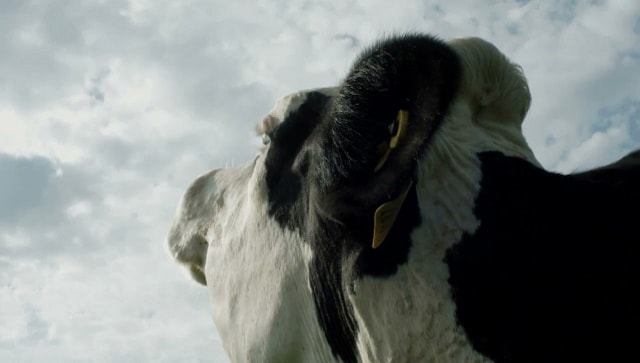By Rahul Desai
Fifty minutes into Andrea Arnold’s first non-fiction feature, the protagonist finds peace. She walks into an open field. Gazes up at the sky. Rests by a tree. Sits in the grass. It is the kind of lens flare moment straight out of Fish Tank and American Honey, Arnold’s fictional features based on young women battling the agency of their bodies.
Here, her freedom is fleeting – either side of this scene, she is held in an industrial facility as a slave. Her body is used as a reproductive machine. When her time in the field is over, she stands at a fork in the road and pauses. She scans both paths. She is not confused; she is reluctant to go back. She feels. She thinks. She sees. And we see her back. Her name is Luma, and she is a cow.
Arnold follows Luma for four years at an English dairy farm in this observational documentary – chronicling her daily life in stark detail. The result is as much a surprisingly moving allegory of feminine identity as it is a study of bovine heart. The cycle of separation, milking, mating, and calving take a toll on Luma, who starts to resemble the bestial counterpart of The Handmaid’s Tale.
Cow is a tough but curiously liberating watch. A lot of it reminded me of the abattoir scenes of the Hungarian drama, On Body and Soul. A farm is not half as brutal, but slow decay makes for a different kind of ‘cinema.’ Luma goes from an active participant to a passive victim over 93 minutes, numbed by years of routine and process. Magda Kowalczyk’s handheld camera operates as a fellow cow, cramping her space but also becoming an expression of her silent language. It often follows her gaze, interpreting her energy and emotions into a tangible narrative – so much is derived from the way Luma looks at other cows, headbutts the camera, stares soulfully into the lens or even refuses to make eye contact.
Or from the way the film opens with Luma calving noisily, with the camera focused on the stickiness of birth – until an hour later, the camera stays on Luma’s dead eyes as a sixth calf is pulled out from her only to be torn away minutes later. She barely licks them clean before they are deposited at another end of the farm. She moos, watches, sighs and, in the finer moments of the film, reflects. I often found myself making up a voiceover for her. I suspect that when I look back at this film years later, I will remember a monologue or three.
Cow brings to mind Gunda, Viktor Kossakovsky’s equally brilliant documentary about the daily life of a piglet. Cow is a bit more realistic and less stylish, in that it refuses to create an illusion of paradise before tearing it down. Luma grazing in the meadow is about as close it comes to a utopian escape.
But perhaps the most distinct aspect of Cow is that it is not an industrial-farming cautionary tale. It does not villainize the humans driving Luma’s misery.
It does not have a message. The farm workers and handlers are simply relegated to voices in the background – they are necessary pawns in the diary ecosystem, going about their job in what feels like a parallel Ken Loach film about the blue-collar countryside.
Luma is not at odds with them so much as her own existence as a product-making animal. The metallic sounds and pregnant gloom of her surroundings are palpable, if only as an antidote to the pop songs that Arnold uses in a way that makes it seem like they were being broadcast by the farm’s speakers. By the end, you feel Luma’s exhaustion – she is not a slaughterhouse cow but being “put out to pasture” is not as literal as it sounds.
While watching Cow, I could not help but wonder: What if this were made in India? Imagine a camera stalking a cow here – and the stories it would trigger. Imagine her perplexed face when humans worship her through the day, riot for her sacred identity, decorate her during festivals, politicise her, and then hijack the cameras and find beef with anyone who looks at her differently. Everyone else will speak for her. Everyone else will decide for her. An industrial farm will morph into a religious farm. Bovinity will morph into divinity. And there would be blood, in a documentary called Bow.
Thankfully, Andrea Arnold upholds the indignity of cow-hood with photojournalistic sharpness. The camera does not interrupt or judge. Luma is allowed to suffer on her own terms. The cowering is entirely human.
[COW is streaming on MUBI India]







Leave A Comment
You must be logged in to post a comment.